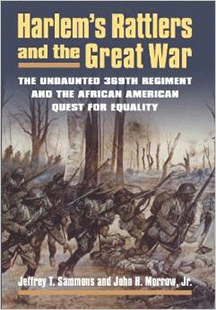The Undaunted 369th Regiment and the African American Quest for Equality
By David Madden
The story of African-American participation in the wars of the country that enslaved them would not be complete without the story of the 369th Regiment. Jeffrey T. Sammons and John H. Morrow, Jr. have told that story; it is now an essential part of the history of World War I. Of course, the story of African-American participation in all America’s wars may never be fully known, partly because of the lingering reluctance of Americans to face up to a history of discrimination that is very long and many-faceted.
The Harlem Rattlers, also called the Harlem Hellfighters, grew out of the 15th New York National Guard. The combat regiment’s reputation was that it “never lost a man to capture or a foot of ground that it had taken.” The authors focus on the heroics of Charles Ward Fillmore, Neadom Roberts, and Henry Johnson during WWI. “I’m an American,” said the iconic Johnson, “and I never retreat.”
The facts are thoroughly researched, as the excellent bibliography and index attest. But the mythic, popular culture dimension of the story is also described fully. For example, the high-profile African-American movie Stormy Weather, starring Lena Horne, presents the two heroes of the regiment in such a way as to reveal many facets of racism as they evolved out of the past and continued to be active on into the decades following the Great War. The movie came out in 1943 when there were very few African-American movies and very few African-American actors and actresses in other movies, except in stereotypical parts. Given the appeal of the story itself and its characters, it is to their credit that the authors never lose their perspective as professional historians.
What makes this story more poignantly accessible is that the history of the two heroes in the war and later in campaigns for equality is delineated by the authors with dramatic flair. The authors take into account, argue with, or support the claims of various historians regarding not only the role of the regiment but of the general struggle for civil rights. The authors mesh the military history of the regiment with the social history of the general movement for African-American equality. They analyze nonfiction and fictional works that tell the story of the regiment in such a way as to convey a vision of the African-American struggle for true freedom.
The two historians reveal the origins and dramatically present the narrative of the combat exploits of this unit during the war and the evolution of the postwar struggles the men had to face. They also adroitly delineate the internal dynamics of the regiment itself and the external pressures upon it. The presence of both black and white officers in the unit constituted an ongoing source of internal pressure. Concerning the external pressures, we must be made mindful that the training occurred in the racist atmosphere of the South; striking contrast to that setting is the performance of this regiment in the French army during World War I.
The American hunger for new perspectives on its history is ever present, and this book contributes to the sustained effort to satisfy that hunger.
Again and again, the authors stress that, more than fighting to make the world safe for democracy, the men of the 369th fought to convince America that it must at long last live up to its democratic promise, fulfilled for many whites, but not for most African-Americans. Johnson and Roberts should be honored, but “not so much for what they did but for what they meant and how they served so many so well for so many years.” Their epic story, both sad and magnificent, is now part of the great war to achieve the unconditional victory of equality.
David Madden, founding director of the United States Civil War Center at LSU, is the author of Sharpshooter (a novel), Classics of Civil War Fiction, Thomas Wolfe’s Civil War, and The Tangled Web of the Civil War and Reconstruction, forthcoming. His latest works of fiction are London Bridge in Plague and Fire and The Last Bizarre Tale (stories).
Jeffrey T. Sammons is a professor of history at New York University and a member of the Phi Beta Kappa Senate. His works include: “Rebel with a Cause: Muhammad Ali as Sixties Protest Symbol” in Muhammad Ali, The People’s Champ, ed. Elliot Gorn (University of Illinois Press, 1995); “‘Race’ and Sport: A Critical Historical Examination” in Journal of Sport History (Fall 1994); and Beyond the Ring: The Role of Boxing in American Society (University of Illinois, 1988).




